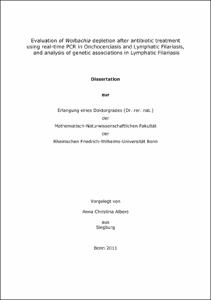Evaluation of Wolbachia depletion after antibiotic treatment using real-time PCR in Onchocerciasis and Lymphatic Filariasis, and analysis of genetic associations in Lymphatic Filariasis

Evaluation of Wolbachia depletion after antibiotic treatment using real-time PCR in Onchocerciasis and Lymphatic Filariasis, and analysis of genetic associations in Lymphatic Filariasis

| dc.contributor.advisor | Hörauf, Achim | |
| dc.contributor.author | Albers, Anna Christina | |
| dc.date.accessioned | 2020-04-17T08:33:16Z | |
| dc.date.available | 2020-04-17T08:33:16Z | |
| dc.date.issued | 15.11.2011 | |
| dc.identifier.uri | https://hdl.handle.net/20.500.11811/5059 | |
| dc.description.abstract | Two of the major filarial infections, onchocerciasis and LF, affect > 150 million people. Currently, control programs use yearly mass application of drugs that mainly kill microfilaria (Mf) with the aim to prevent uptake by transmitting insect vectors and thus, to block transmission and reduce infections. It has been known for more than 35 years that filarial nematodes contain endosymbiotic bacteria of the genus Wolbachia. The discovery of the essential role of Wolbachia in worm fertility and survival has resulted in the development of antifilarial chemotherapy with doxycycline, which depletes Wolbachia from the worms and leads to long-term worm sterility and macrofilaricidal activity in human LF and onchocerciasis.\par To improve diagnostic methods beside microscopic and histological analysis in filarial infections with Onchocerca volvulus, Wuchereria bancrofti and Brugia malayi, several real-time PCRs were established to: 1) monitor Wolbachia depletion in studies with humans looking at the efficacy of different dosages and treatment times for doxycycline and alternative anti-wolbachial drugs, 2) analyse the effect of Wolbachia depletion by doxycycline on larval development in the insect vector and 3) establish a more sensitive method of identifying amicrofilaremic Brugian infections. To these, the Wolbachia ftsZ single copy gene and the Brugia malayi HhaI gene were quantified by real-time PCR.\f0\par \f1 The second arm of the thesis project was a genetic association study in LF patients. \lang1033 Studies in humans have shown that susceptibility to infection, parasite load and lymphatic pathology cluster in families but only a few studies have looked for genes associated with LF. In total 30 SNPs were analyzed and genotypes were compared between LF patients with MF or LE phenotypes. Two SNPs of the IL-18 gene and two SNPs of the IL-4R gene showed an association to LF phenotypes in a group of patients from Indonesia infected with Brugia timori. | en |
| dc.language.iso | eng | |
| dc.rights | In Copyright | |
| dc.rights.uri | http://rightsstatements.org/vocab/InC/1.0/ | |
| dc.subject | Real time quantitative PCR | |
| dc.subject | Lymphatische Filariose | |
| dc.subject | Onchozerkose | |
| dc.subject | Wolbachia | |
| dc.subject | Genetik | |
| dc.subject | Lymphatic Filariasis | |
| dc.subject | Onchocerciasis | |
| dc.subject | Genetics | |
| dc.subject.ddc | 500 Naturwissenschaften | |
| dc.subject.ddc | 570 Biowissenschaften, Biologie | |
| dc.subject.ddc | 610 Medizin, Gesundheit | |
| dc.title | Evaluation of Wolbachia depletion after antibiotic treatment using real-time PCR in Onchocerciasis and Lymphatic Filariasis, and analysis of genetic associations in Lymphatic Filariasis | |
| dc.type | Dissertation oder Habilitation | |
| dc.publisher.name | Universitäts- und Landesbibliothek Bonn | |
| dc.publisher.location | Bonn | |
| dc.rights.accessRights | openAccess | |
| dc.identifier.urn | https://nbn-resolving.org/urn:nbn:de:hbz:5N-26946 | |
| ulbbn.pubtype | Erstveröffentlichung | |
| ulbbnediss.affiliation.name | Rheinische Friedrich-Wilhelms-Universität Bonn | |
| ulbbnediss.affiliation.location | Bonn | |
| ulbbnediss.thesis.level | Dissertation | |
| ulbbnediss.dissID | 2694 | |
| ulbbnediss.date.accepted | 21.10.2011 | |
| ulbbnediss.fakultaet | Mathematisch-Naturwissenschaftliche Fakultät | |
| dc.contributor.coReferee | Sahl, Hans-Georg |
Dateien zu dieser Ressource
Das Dokument erscheint in:
-
E-Dissertationen (4379)




